Capn Craig
Guru
- Joined
- Oct 16, 2010
- Messages
- 519
As I scrape My teak cabin doors in preparation for a Cetol coating. I'm learning that there is an art to effective scraping. The process of varnish removal is much easier than I anticipated, except My learning has not come at the expense of some screw ups. Here is my first and biggest so far. My Milwaukee heat gun puts out some wicked heat, It doesn't take long to soften the varnish. If your not careful, I wasn't, it is very easy to scorch the teak. You don't realize you are doing it until you see the slightly black place. Now that I have scorched a few places, I am finding it darn near impossible to make it go away with sand paper. It seems that the charcoal from the scorch just works its way deeper and deeper as you sand. The best luck I have had so far is sand just a little, then use a brush tipped nozzle on the shop vac to vacuum the wood and the sandpaper, then sand just a little more and repeat the process. I have trying washing the surface with MEK and a clean white paper towel and get any black up. I have tried sanding the still wet MEK soaked wood in hopes that perhaps the black charcoal would stick better to the sanding dust. That doesn't work either.
Anybody got advice??
Craig
Anybody got advice??
Craig






